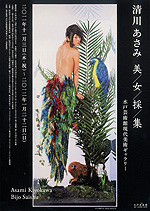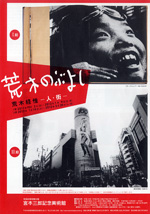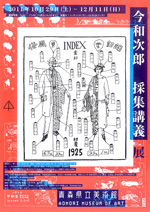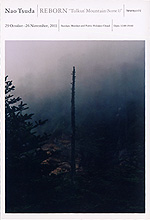 |
Picks is a monthly sampling of Japan's art scene, offering short reviews of exhibitions at museums and galleries in recent weeks, with an emphasis on contemporary art by young artists. |
 |
 |
 |
16 January 2012 |
 |
| 1 | 2 | |
 |
|
 |
 |
|
|
 |
 |
 |
 |
| Asami Kiyokawa: Bijo Saishu (Collecting Beautiful Girls) |
| 3 November 2011 - 22 January 2012 |
Contemporary Art Center, Art Tower Mito
(Ibaraki) |
 |
| While attending Bunka Fashion College, Kiyokawa started working as a model, but then diversified into contemporary art, picture books, advertising, and clothing design. This is her first major solo show, however. Making optimum use of the space at Mito's Art Center, she has assembled a startling "collection" of photos of beautiful actresses and singers, which she has embroidered with colorful threads and cloth. In her latest series she poses her models with endangered species of plants and animals, to flamboyant but elegant effect. |
|
 |
 |
 |
 |
|
|
Nobuyoshi Araki: Hito, Machi (Person, Town)
|
2 October 2011 - 9 January 2012;
14 January - 20 March 2012 |
Miyamoto Saburo Annex, Setagaya Art Museum
(Tokyo) |
 |
| No longer the bad boy but the grand old man of postwar Japanese photography, Araki (b. 1940) is treated to a thorough retrospective divided into two parts. The first, which ended January 9, featured such seminal series as his debut Satchin and His Brother Mabo and the provocative Tokyo Lucky Hole and Tokyo Nude. Part 2, currently up, is a tad more restrained with Subway, Zoo, and Tokyo Story. It is a small-scale but solid show. Most impressive are the scrapbooks that contain his earliest work: their huge newssheet-size images are far more forceful than the prints on the wall. |
|
|
|
|

|
 |
 |
 |
|
Wajiro Kon Retrospective |
| 14 January - 25 March 2012 |
Shiodome Museum
(Tokyo) |
 |
| Opening in Tokyo after a run last fall at the Aomori Museum of Art, this thoroughgoing look at the diverse output of architect Kon (1888-1973) employs a cornucopia of sketches, photos, design drawings, and models to illustrate his work as a surveyor of traditional Japanese houses, a member of the artist-run "Barrack Decoration Company" following the Kanto Earthquake of 1923, and the founder of the discipline known as modernology. Less well known but amply covered here is his career as a designer. |
|
|
 |
 |
|
Nao Tsuda: REBORN "Tilkus' Mountain (Scene 1)" |
|
29 October - 26 November 2011
|
|
hiromiyoshii
(Tokyo) |
 |
| In these new works, photographer Tsuda focuses on the forests and people of the Himalayan kingdom of Bhutan. In his Smoke Line exhibition of 2008, Tsuda's images seemed to draw the viewer's eyes to the side, into horizontally expansive landscapes. Here, however, everything is vertical: trees thrust straight up out of the forests, pagodas and stupas tower above, and the young Buddhist monks stand upright. |
|
|
|
|
|
|
|

|
 |
 |
|
|
 |
|